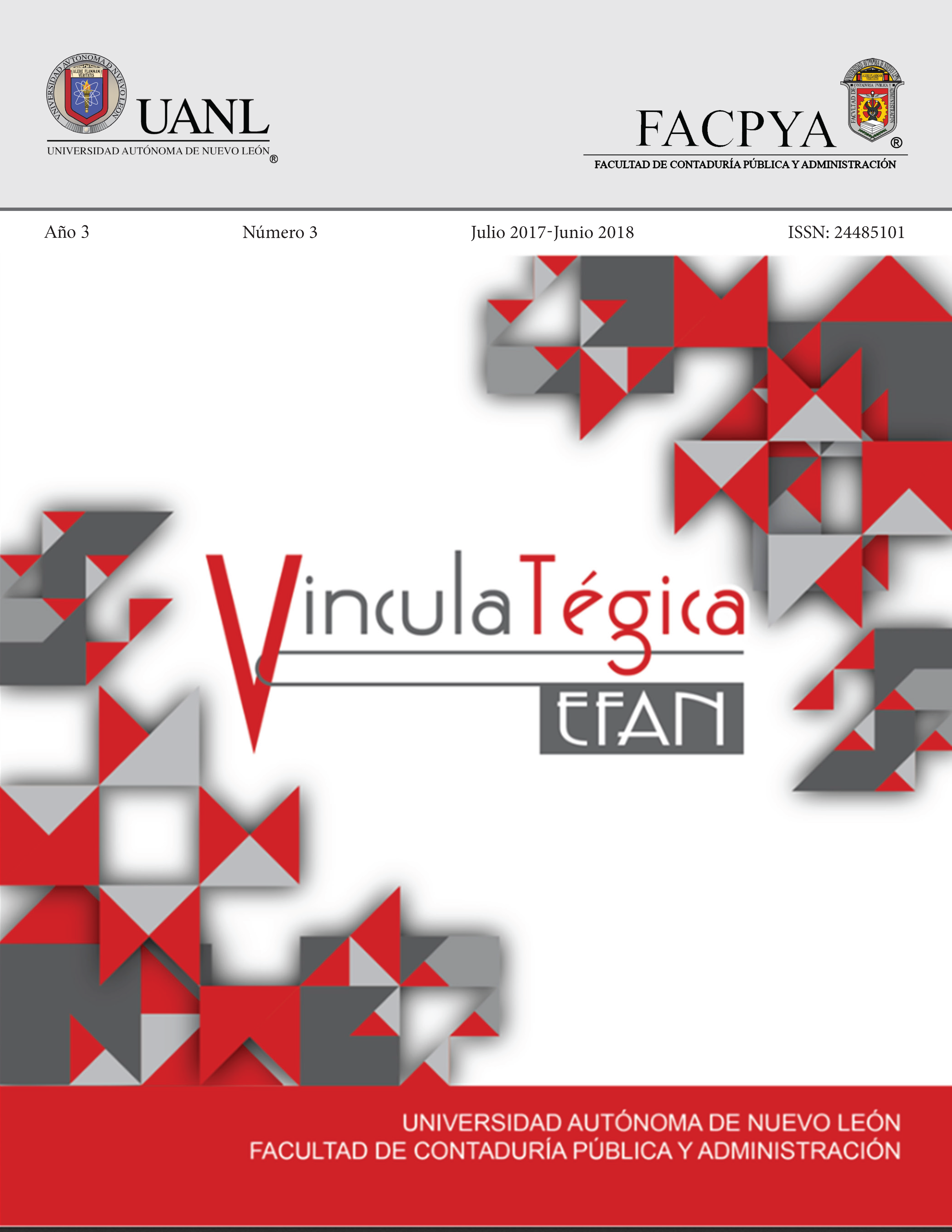Factores que Limitan la Formalización de las Micro y Pequeñas del Sector Manufacturero en Perú
DOI:
https://doi.org/10.29105/vtga3.3-997Keywords:
Perú, Pequeñas y micro empresas, informalidadAbstract
Currently Peru is a country that within the international context is considered an emerging economy, with growth rates above the average in the region and with a fairly high development potential, however despite these strengths, is permanently threatened by the shadow of an essentially informal 202 economy. Although informal companies provide livelihoods for millions of people, their role limits the growth and economic development of countries. The objective of this research project is to analyze from a theoretical perspective the critical factors that limit the formalization of small and microenterprises in the national manufacturing sector in Peru. Therefore, after an exhaustive analysis of the theoretical documentation, the complex procedure, the tax regime, the deficient productive structure and the low level of training are hypothesized. The theoretical support of these variables is presented
Downloads
References
Aguirre, A. (2013). Evasión tributaria en los comerciantes de abarrotes ubicados en los alrededores del mercado mayorista del distrito de Trujillo - año 2013. Universidad Privada Antenor Orrego. Facultad de Ciencias Económicas Escuela Profesional de Contabilidad.
Agüero, A. y Pérez, P. (2010). El uso de Internet de los trabajadores independientes y microempresarios en el Perú. In Investigación presentada en la Conferencia ACORNREDECOM.
Avolio, B., Mesones, A., & Roca, E. (2011). Factores que limitan el crecimiento de las micro y pequeñas empresas en el Perú (MYPES). Strategia, (22), 70-80.
Bryan, J. (2006). Training and performance in small firms. International small business journal, 24(6), 635-660. DOI: https://doi.org/10.1177/0266242606069270
Castells, M. y A. Portes. (1989). World Underneath: The Origins, Dynamics, and Effects of the Informal Economy. En A. Portes, M. Castells & Lauren A. Benton, eds. The Informal Economy: Studies in Advanced and Less Advanced Developed Countries. Baltimore, MD, USA: John Hopkins University Press.
Chen. M. (2012). The Informal Economy: Definitions, theories and policies. USA. Women in Informal Employment: Globalizing and Organizing (WIEGO)
De Soto, H. (1986). The Other Path. London: I.B. Tauris & Co Ltd.
Dreher, A., & Schneider, F. (2010). Corruption and the shadow economy: an empirical analysis. Public Choice, 144(1-2), 215-238. DOI: https://doi.org/10.1007/s11127-009-9513-0
Forbes (2014). 5% del PIB proviene de la informalidad. Recuperado desde http://www.forbes.com.mx/25-del-pib-proviene-de-la-informalidad/#gs.wllH8LU
Gestión (2017, enero, 18). Sunat: Régimen Mype Tributario pagará menos impuestos. Recuperado desde http://gestion.pe/economia/sunat-regimen-mype-tributario-pagara-menos-impuestos2179990
Gestión (2014, octubre, 14). Menos del 20% de mypes acceden a capacitación, según Cofide. Recuperado desde http://gestion.pe/empresas/menos-20-mypes-acceden-capacitacion-seguncofide-2111038
Gibb, A. A. (1997). Small firms' training and competitiveness. Building upon the small business as a learning organisation. International small business journal, 15(3), 13-29. DOI: https://doi.org/10.1177/0266242697153001
Hart, K (1973). Informal Income Opportunities and Urban Employment in Ghana. The Journal of Modern African Studies, 11, pp 61-89 DOI: https://doi.org/10.1017/S0022278X00008089
INDECOPI. (2017). Eliminación de Barreras Burocráticas. Recuperado desde https://www.indecopi.gob.pe/web/eliminacion-de-barreras-burocraticas/presentacion
Instituto Nacional de Estadística e Informática-INEI. (2014). Producción y empleo informal en el Perú. Cuenta Satélite de la Economía Informal 2007-2012. INEI, Lima. 212
Instituto Nacional de Estadística e Informática-INEI. (2015). Resultados de la Encuesta Nacional de Hogares (ENAHO). INEI, Lima.
Jessup, G. (1991). Outcomes. NVQs and the Emerging Model of Education and Training. The Falmer Press, London.
Johnson, S. & Gubbins, A. (1992) ‘Training in Small and Medium-sized Enterprises: Lessons from North Yorkshire ‘, in K. Caley, E. Chell, F. Chittenden and C. Mason (eds) Small Enterprise Development Policy and Practice in Action, pp. 28–42. London: Paul Chapman.
Keogh, W. and Stewart, V. (2001) ‘Identifying the Skills Requirements of the Workforce in SMEs: Findings from a European Social Fund Project’. Journal of Small Business and Enterprise Development 8(2) 140–9. DOI: https://doi.org/10.1108/EUM0000000006817
Kucera, D., & Roncolato, L. (2008). Informal employment: Two contested policy issues. International Labour Review, 147(4), 321-348. DOI: https://doi.org/10.1111/j.1564-913X.2008.00039.x
Lee, H., Kelley, D., Lee, J., & Lee, S. (2012). SME survival: the impact of internationalization, technology resources, and alliances. Journal of small business management, 50(1), 1-19. DOI: https://doi.org/10.1111/j.1540-627X.2011.00341.x
Martocchio, J. J. and Baldwin, T. T. (1997) ‘The Evolution of Strategic Organisational Training’, Research in Personnel and Human Resource Management 15, 1–46.
Merchán, Mario., Velázquez, Nazareth. (2015). La evasión y elusión tributaria de las mype en las empresas del sector comercio-rubro abarrotes del distrito de Chimbote, 2014. In Crescendo. Derecho. 2015; 2(2), 19-27
Ministerio de Relaciones Exteriores. (2016). Guía de Negocios e Inversiones del Perú, 2015-2016.
Organización Internacional del Trabajo. (2015). Políticas para la formalización de las micro y pequeñas empresas en América Latina. Experiencias, avances y desafíos. Santiago.
Portes, A. y Haller, W. (2004). La economía informal. Serie Políticas Sociales N°100. Santiago: CEPAL.
Sánchez-Villagómez, M., Vara-Horna, A., Paredes-Pérez, N., Alvarez-Risco, A., Vílchez-Román, C., Santi-Huaranca, I., Huamán-Delgado, F. (2016). Revisión teórica de la informalidad. Manuscrito no publicado, Universidad de San Martín de Porres, Lima, Perú.
Schneider, F., & Enste, D. H. (2013). The shadow economy: An international survey. Cambridge University Press. DOI: https://doi.org/10.1017/CBO9781139542289
Schneider, F. (2014). In the Shadow of the State-the Informal Economy and Informal Economy Labor Force. DANUBE: Law and Economics Review, 5(4), 227-248. DOI: https://doi.org/10.2478/danb-2014-0013
Scott, P., Jones, B., Bramley, A. and Bolton B. (1996) ‘Enhancing Technology and Skills in Small and Medium Sized Manufacturing Firms: Problems and Prospects’, International Small Business Journal 14(3), 85–99. DOI: https://doi.org/10.1177/0266242696143005
Sunat (2017). Cultura aduanera y tributaria. http://cultura.sunat.gob.pe/index.php/por-que-tributamos
Tokman, V. (1978). An Exploration into the Nature of the Informal-Formal Sector Relationship. World Development, Vol. 6, Núm. 9/10. DOI: https://doi.org/10.1016/0305-750X(78)90063-3
Velis, C., Wilson, D., Rocca, O., Smith, S., Mavropoulos, A., Cheeseman, C. (2012). An analytical framework and tool (‘InteRa’) for integrating the informal recycling sector in waste and resource management systems in developing countries. Waste Manage. Res. 30 (9), 43–66. http://dx.doi.org/10.1177/0734242X12 454934. DOI: https://doi.org/10.1177/0734242X12454934
Downloads
Published
How to Cite
Issue
Section
License

This work is licensed under a Creative Commons Attribution 4.0 International License.
a). Authors keep copyright and give the journal the right of the first publication of the work under a Creative Commons attribution license. This license allows others to share the work as long as original authorship and initial publication in this journal is acknowledged.
b). Authors may make other independent and additional contractual agreements for the non-exclusive distribution of the version of the article published in this journal (e.g., include it in an institutional repository or publish it in a book) as long as they clearly indicate that the work was published for the first time in this journal.







